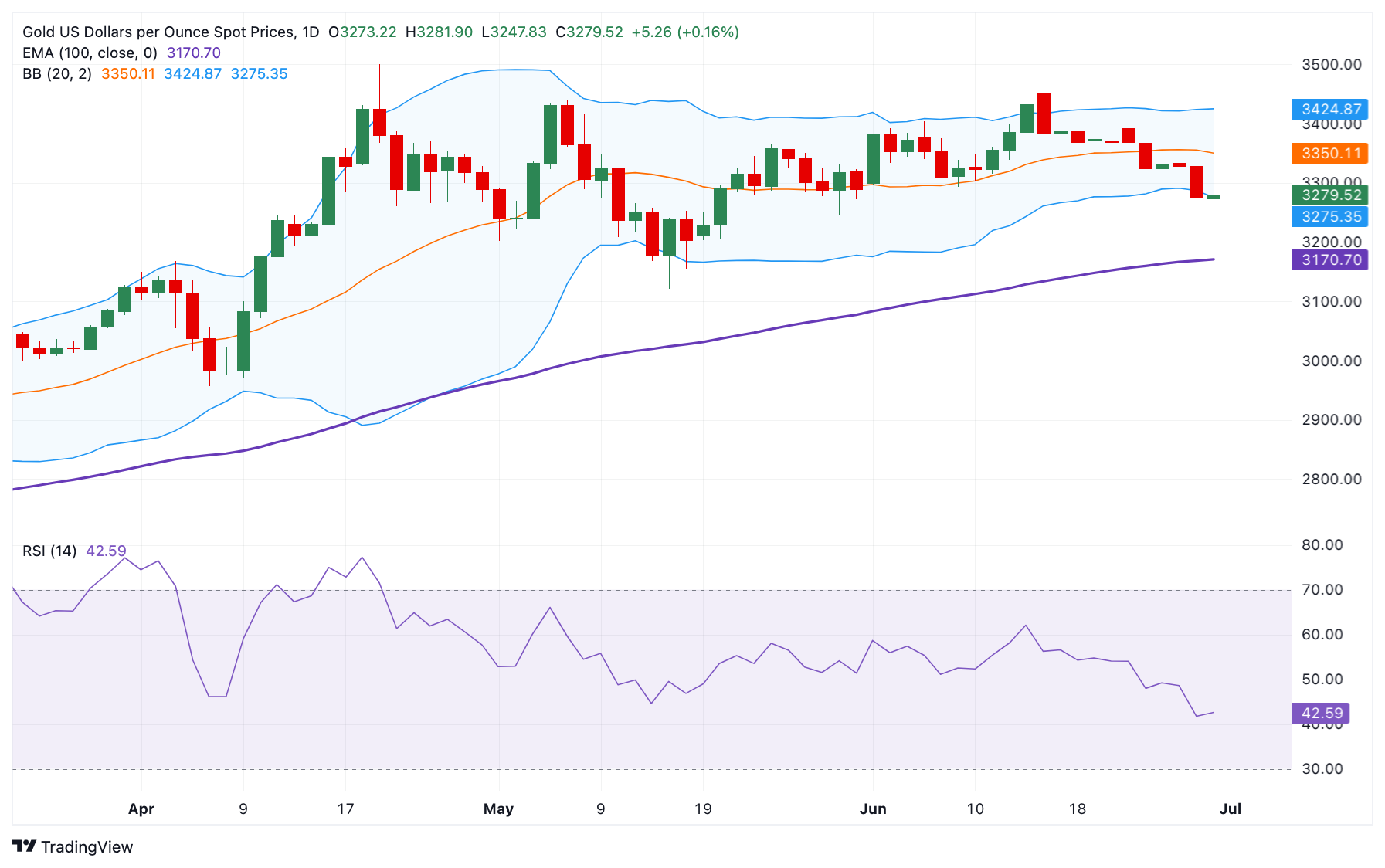- Gold price drifts higher in Monday’s early European session.
- Optimism over US trade deals bolstered bets for earlier Fed rate cuts, supporting the Gold price.
- Traders brace for the Fedspeak later on Monday for a fresh impetus.
The Gold price (XAU/USD) recovers some lost ground during early European trading hours on Monday. Rising bets that the US Federal Reserve (Fed) will cut rates more times this year and possibly sooner than previously expected might undermine the Greenback and support the USD-denominated commodity price as a weaker USD makes Gold cheaper for foreign buyers.
Nonetheless, improved risk sentiment due to the US-China trade agreement, along with the ceasefire deal between Israel and Iran could diminish bullion’s appeal as a traditional safe-haven asset. Traders brace for the Fedspeak later on Monday. The Atlanta Fed President Raphael Bostic and Chicago Fed President Austan Goolsbee are scheduled to speak.
Daily Digest Market Movers: Gold price gains ground on increased optimism of a Fed rate cut
- “The slowdown in geopolitics has offered an opportunity for investors to start taking profit because of the forward-looking prospects of some kind of kinetic war with China and the developments in the Middle East,” said Daniel Pavilonis, senior market strategist at RJO Futures.
- Top US President Donald Trump advisers said on Friday that agreements with as many as a dozen of the US’s largest trading partners are expected to be completed by the July 9 deadline, per Bloomberg.
- US Personal Spending unexpectedly fell by 0.1% in May, the second decline this year, according to the US Bureau of Economic Analysis on Friday. Meanwhile, US Personal income dropped by 0.4% in May, the largest decrease since September 2021.
- The US Personal Consumption Expenditures (PCE) Price Index rose by 2.3% YoY in May, compared to 2.2% in April (revised from 2.1%), the US Bureau of Economic Analysis reported on Friday. This reading came in line with market expectations.
- The core PCE Price Index, which excludes volatile food and energy prices, climbed 2.7% in May, following the 2.6% increase (revised from 2.5%) seen in April. On a monthly basis, the PCE Price Index and the core PCE Price Index increased 0.1% and 0.2%, respectively.
Gold price retains a bullish tone in the longer term
The Gold price trades in positive territory on the day. Technically, the precious metal keeps the bullish vibe on the daily chart, with the price holding above the key 100-day Exponential Moving Average (EMA). However, in the near term, the 14-day Relative Strength Index (RSI) is located below the midline near 41.50, suggesting further downside looks favorable.
The first upside barrier for yellow metal emerges near $3,350, the high of June 26. Sustained trading above this level could take XAU/USD back toward the $3,400 psychological level, en route to $3,425, the upper boundary of the Bollinger Band.
In the bearish event, the initial support level for yellow metal is seen at $3,170, the 100-day EMA. A break below the mentioned level might even drag the gold price toward $3,120, the low of May 15.

Risk sentiment FAQs
In the world of financial jargon the two widely used terms “risk-on” and “risk off” refer to the level of risk that investors are willing to stomach during the period referenced. In a “risk-on” market, investors are optimistic about the future and more willing to buy risky assets. In a “risk-off” market investors start to ‘play it safe’ because they are worried about the future, and therefore buy less risky assets that are more certain of bringing a return, even if it is relatively modest.
Typically, during periods of “risk-on”, stock markets will rise, most commodities – except Gold – will also gain in value, since they benefit from a positive growth outlook. The currencies of nations that are heavy commodity exporters strengthen because of increased demand, and Cryptocurrencies rise. In a “risk-off” market, Bonds go up – especially major government Bonds – Gold shines, and safe-haven currencies such as the Japanese Yen, Swiss Franc and US Dollar all benefit.
The Australian Dollar (AUD), the Canadian Dollar (CAD), the New Zealand Dollar (NZD) and minor FX like the Ruble (RUB) and the South African Rand (ZAR), all tend to rise in markets that are “risk-on”. This is because the economies of these currencies are heavily reliant on commodity exports for growth, and commodities tend to rise in price during risk-on periods. This is because investors foresee greater demand for raw materials in the future due to heightened economic activity.
The major currencies that tend to rise during periods of “risk-off” are the US Dollar (USD), the Japanese Yen (JPY) and the Swiss Franc (CHF). The US Dollar, because it is the world’s reserve currency, and because in times of crisis investors buy US government debt, which is seen as safe because the largest economy in the world is unlikely to default. The Yen, from increased demand for Japanese government bonds, because a high proportion are held by domestic investors who are unlikely to dump them – even in a crisis. The Swiss Franc, because strict Swiss banking laws offer investors enhanced capital protection.

